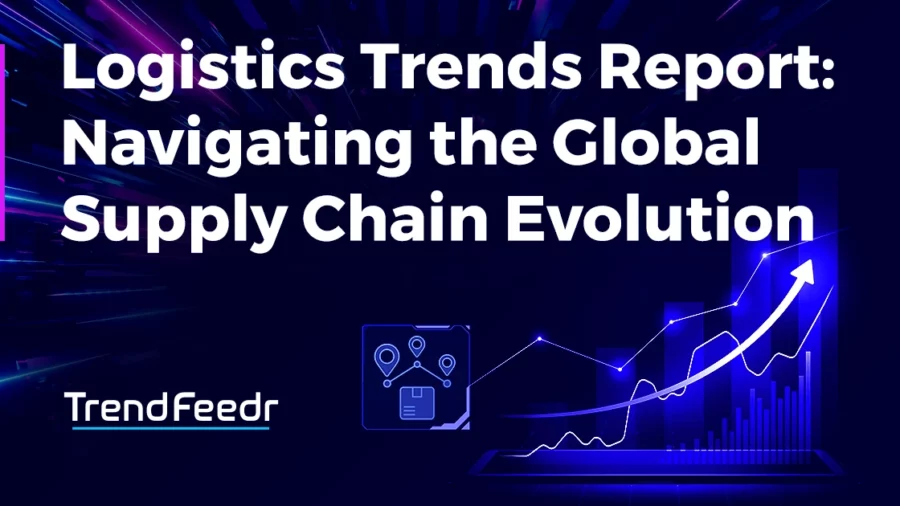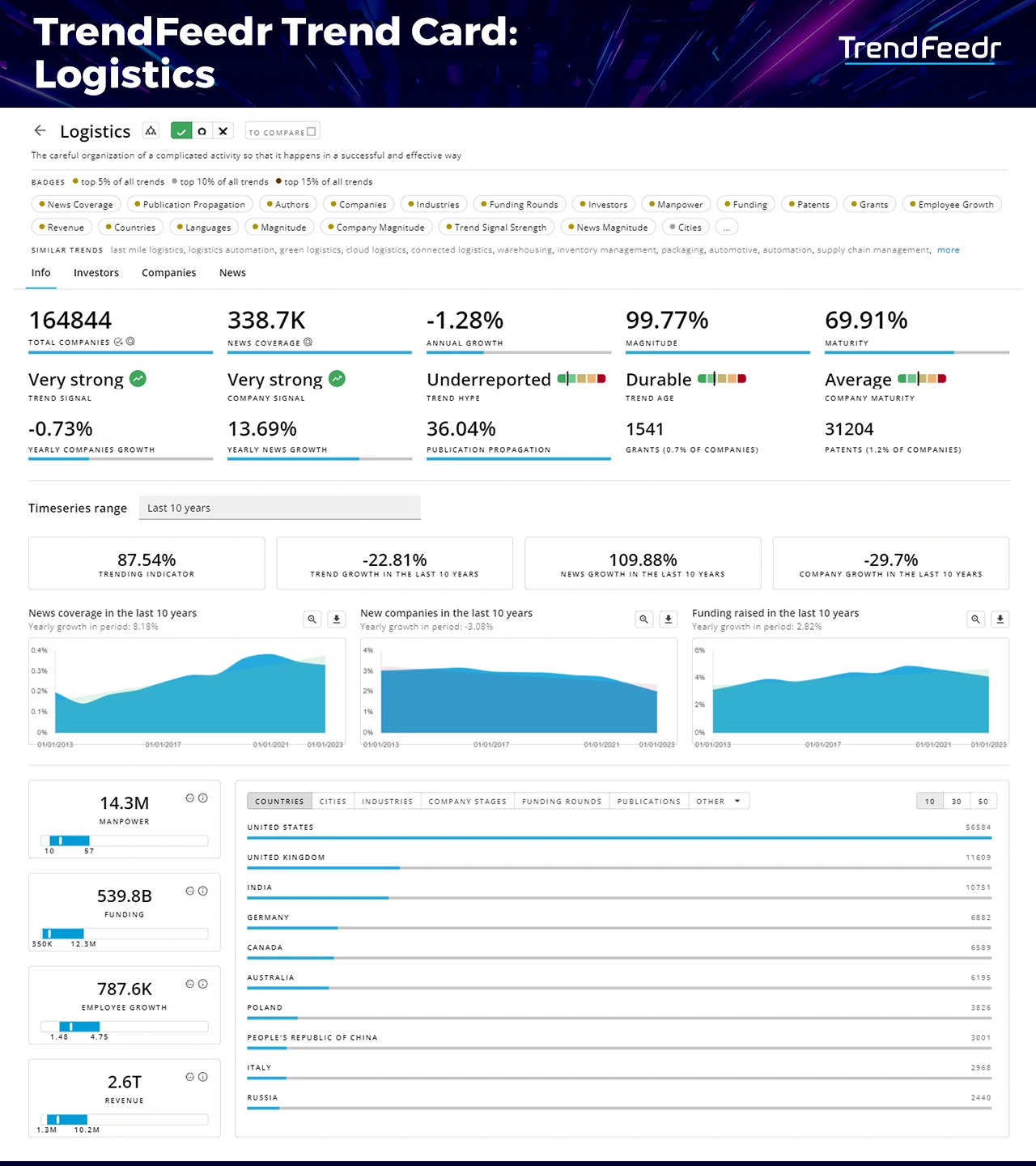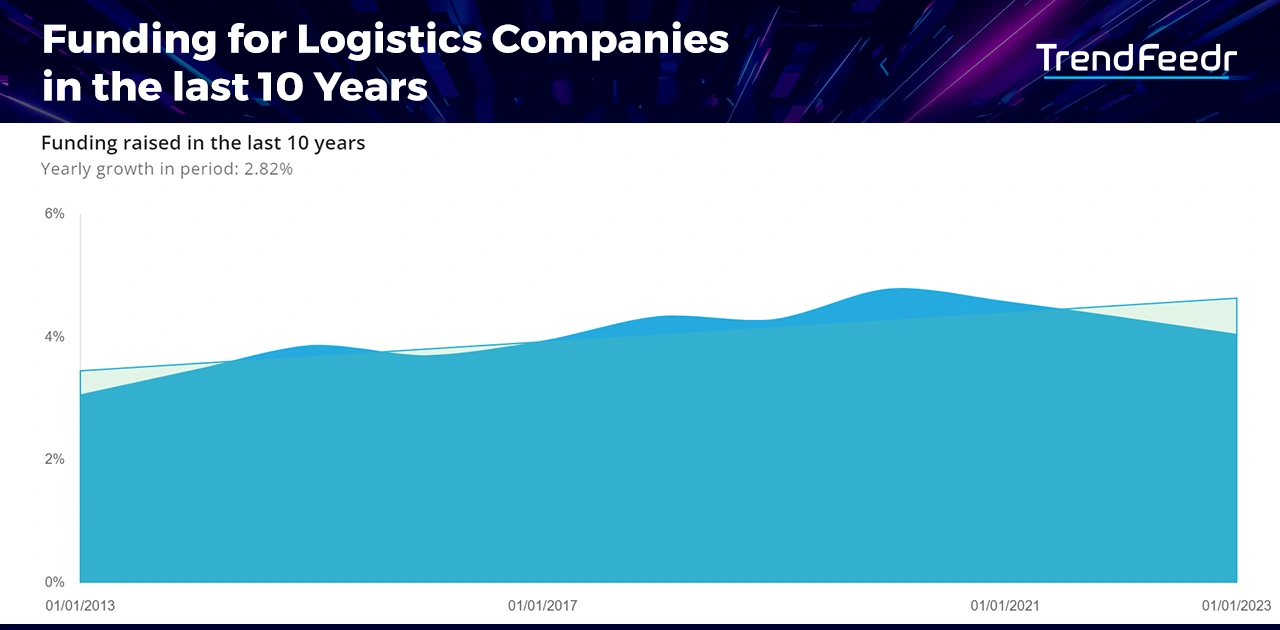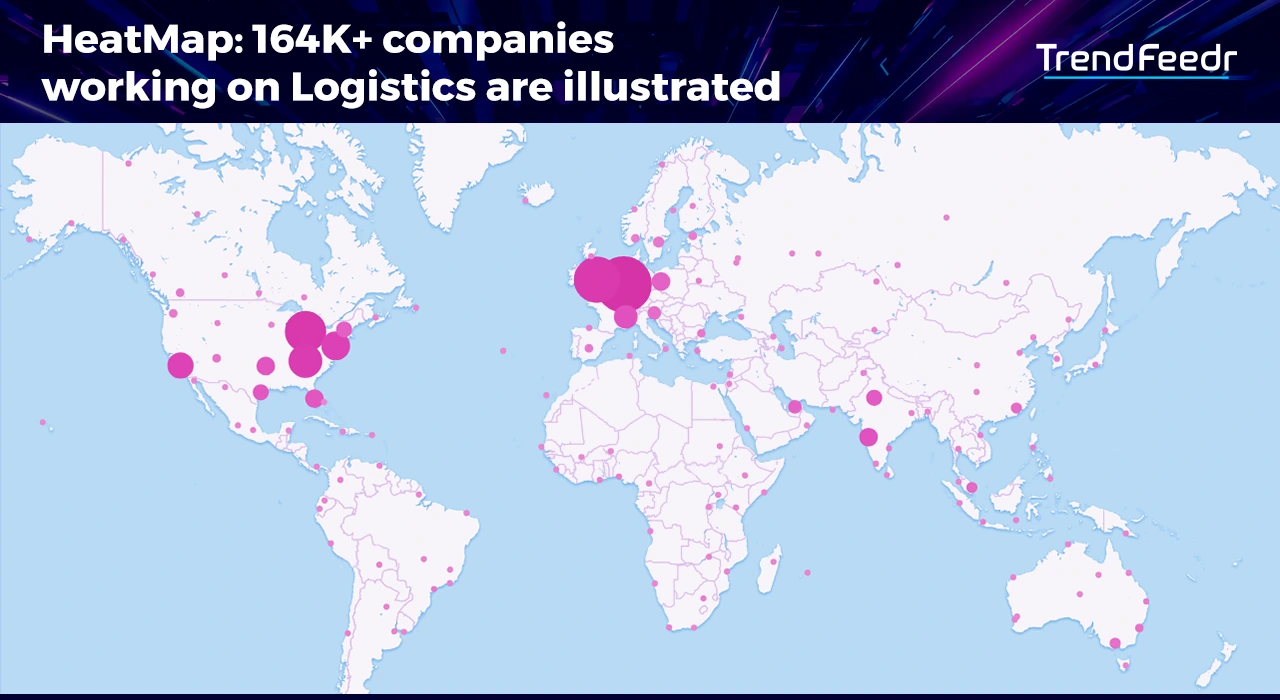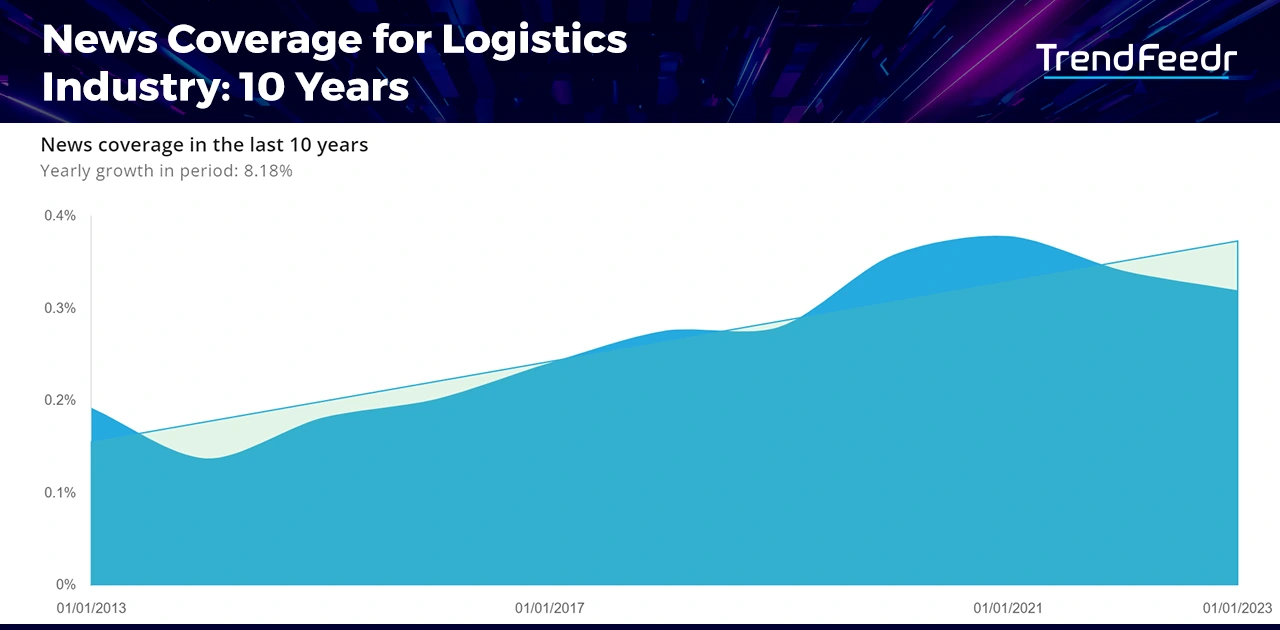This logistics trends report underscores the critical role of technologies in the complex world of global trade. It emphasizes how emerging technologies provide a vital framework that facilitates the efficient movement of goods, information, and resources. They are innovative solutions that turn challenges into opportunities and redefine the future of global trade.
Currently, the logistics industry is undergoing a significant transformation with the integration of advanced technologies like artificial intelligence (AI) and the Internet of Things (IoT). They provide unparalleled transparency and efficiency to logistics operations.
The impact of these logistics trends is substantial and has the potential to establish a more interconnected and robust global supply chain. Current logistics market trends highlight the significant influence and growth potential of these trends. According to Precedence Research, the global logistics market, which was valued at an impressive US$7.98 trillion in 2022, is projected to grow at a compound annual growth rate (CAGR) of 10.7% from 2023 to 2030, reaching a staggering US$18.23 trillion.
Further highlighting the industry’s progress, Gitnux predicts that the global market for warehouse automation will reach approximately US$30 billion by 2026. This increase is primarily due to automation’s essential role in improving operational efficiency.
In this data-driven logistics trends report, we delve into the current trends in logistics, emphasizing last-mile logistics, logistics automation, green logistics, cloud logistics, and connected logistics.
Key Takeaways
- Ubiquitous Impact: According to TrendFeedr, logistics stands out as a pervasive force, with a trend magnitude of 99.77% and a trend maturity of 69.91%.
- Holistic Approach: Logistics firms are broadening their approaches to include a diverse range of trends, such as last-mile logistics, logistics automation, green logistics, cloud logistics, and connected logistics.
- Media Attention: The sector has seen a significant annual increase of 8.18% in logistics news coverage over the past decade, highlighting its crucial role in the global economy and its potential for innovation and transformation.
- Investment and Expansion: The logistics field is bustling with activity, with approximately 164,000 entities actively driving the industry forward and collectively attracting investment capital of around US$545 billion.
- Major players like Tiger Global Management, Alibaba Group, and Warburg Pincus are making significant investments in logistics, directing billions into initiatives set to reshape the industry.
- Global Footprint: Countries such as the United States, United Kingdom, India, Germany, and Canada, and major cities like London, New York City, Sydney, Dubai, and Melbourne are leading the way in logistics innovation and adoption.
Table of Contents
- Understanding Logistics Trends
- Logistics Trend Card
- Emerging Trends & Technologies Disrupting Logistics
- Key Logistics Trends
- Emerging Logistics Companies
- Logistics Investment Trends
- Mapping Logistics Companies
- Media Coverage of Logistics
- Future of Logistics
For this detailed analysis of logistics trends, we use TrendFeedr, our all-in-one trend intelligence platform. TrendFeedr uses advanced algorithms to identify future industry and tech trends. With a focus on trend discovery, clustering, and analysis, the AI-powered platform reviews thousands of trends each week to provide actionable insights.
Among more than 20,000 trends and technologies monitored by TrendFeedr, logistics has made a significant impact. Here’s why:
- Logistics is among the top 50 trends and ranks within the top 1% of global trends, emphasizing its vital role in supply chain management and international trade.
- With a maturity level of 69.91%, the sector demonstrates significant growth and adoption across various industries, indicating a shift towards more sophisticated and integrated logistics solutions.
- The logistics revolution is transforming business operations by significantly enhancing efficiency, reducing costs, extending global reach, and greatly improving customer satisfaction.
This logistics report explores various aspects including performance, investment, regional, and future outlook.
Understanding Logistics Trends
The innovative trends and advanced technologies in the logistics industry are contributing to a more efficient, transparent, and resilient global supply chain. Here’s more about them in detail:
What are trends in logistics?
Sustainable logistics, one of the key trends in logistics, increasingly focuses on reducing the environmental footprint of logistics operations. This leads to the adoption of eco-friendly practices and sustainable solutions. Companies are exploring ways to reduce emissions, optimize routes, and integrate renewable energy sources into their operations.
Supply chain visibility is another growing trend. Companies are harnessing the power of data analytics, IoT, and blockchain to gain real-time insights, enhance transparency, and improve decision-making capabilities.
Increasingly, the digitization of freight brokerage is also gaining momentum, with AI and machine learning-powered platforms streamlining the process of connecting shippers with carriers for more efficient matchmaking, pricing, and tracking.
Further, the surge in online shopping is necessitating the evolution of e-commerce fulfillment solutions. To keep pace with this exponential growth, companies are investing in automation and data analytics to improve the speed and accuracy of order processing, delivery, and returns.
Lastly, innovations in last-mile delivery are addressing challenges associated with the final stage of the supply chain. This includes the use of drones, autonomous vehicles, and smart lockers to ensure timely and cost-effective deliveries.
What are advanced technologies used in logistics?
AI and machine learning (ML) are at the forefront of logistics innovation, offering smart solutions for demand forecasting, route optimization, inventory management, and customer service. The IoT plays a pivotal role in the real-time tracking and monitoring of goods, vehicles, and equipment. These devices generate valuable data that enhances visibility across the supply chain and facilitates predictive maintenance.
In parallel with IoT, blockchain creates secure, transparent, and tamper-proof records of transactions and movements within the supply chain. The incorporation of robotics and automation in warehouses and fulfillment centers is enhancing efficiency, minimizing errors, and boosting overall productivity. Lastly, the utilization of big data and advanced analytics is empowering companies to derive meaningful insights from vast volumes of data. This leads to better decision-making processes and optimized operations.
Logistics Trend Card: Explore the Most Recent Developments in the Logistics Landscape
The logistics industry serves as the backbone of global trade and the circulation of goods, and its dynamics can be captured from TrendFeedr’s Logistics Trend Card. Let’s dive into the numbers to understand the evolving landscape:
- Company Landscape: 164,844 companies are operating within the logistics sector. However, the industry is experiencing a slight contraction in new companies, with a decrease of -1.28% in the annual growth.
- Media Attention: The logistics industry is garnering considerable media attention, with a substantial 338.7K news articles, reflecting a robust 13.69% growth in yearly news coverage.
- Innovation and Growth: The sector shows a strong innovation pulse, with 31,204 patents granted, hinting at a fertile ground for technological advancements and operational improvements.
- Industry Dynamics: Over the last decade, there has been a remarkable 109.88% growth in news coverage, highlighting increasing public and investor interest. Despite this, there has been a 29.7% decline in new companies’ growth over the last ten years, indicating potential market consolidation or other challenging conditions for new entrants.
- Employment and Revenue: The logistics industry is a major employer, boasting 14.3 million manpower, and a powerhouse in terms of revenue, generating a staggering US$2.6 trillion.
- Geographic Spread: The United States, United Kingdom, and India top the list of countries with active logistics companies, pointing to their strategic positions in global supply chains.
- Sustainability and Maturity: The trend magnitude stands at a remarkable 99.77%, underscoring the profound impact and reach of logistics trends on a global scale. This places it within the top 1% of global trends. However, a trend maturity of 69.91% indicates a landscape brimming with potential, with innovations and shifts still in progress.
Keep reading as the subsequent sections offer a wealth of insights, analysis, and foresight into the ever-evolving world of logistics.
Looking for all trends related to logistics?
How Do Emerging Trends and Technologies Disrupt the Logistics Industry?
The logistics industry is undergoing a major transformation as emerging trends and technologies introduce new levels of efficiency and sustainability. In this section, we will explore some trends and technologies that are reshaping the logistics landscape:
Last Mile Logistics
The final segment of the delivery process is vital and often the most difficult. Emerging technologies are enabling faster and more cost-effective deliveries in this space.
For instance, Crossbay offers a last-mile logistics platform that improves the delivery of goods and services. It operates single-user distribution centers near key gateway cities, supporting the growing demand for on-demand deliveries. The company also uses a network of logistics hubs to optimize last-mile delivery, reducing transit time and enhancing customer satisfaction.
Logistics Automation
The automation of logistics processes is essential in improving operational efficiency and accuracy. It covers everything from automated storage and retrieval systems to autonomous vehicles and drones.
Packlogic provides automated, right-sized packaging solutions and logistics automation for warehouses, distribution centers, and manufacturers. Its technology improves economic efficiency by reducing packaging waste and offers environmental benefits by minimizing the carbon footprint of packaging and distribution.
Green Logistics
The drive for sustainability is prompting a major rethink in logistics operations. Companies are investing in green logistics to lower their environmental impact and to meet regulatory and consumer demand for sustainable practices.
FITSOL stands out with its AI-powered SaaS platform for carbon management in logistics. The software allows businesses to monitor and reduce carbon emissions throughout the supply chain. The startup also provides eco-friendly packaging and logistics services that leverage renewable energy and vehicle optimization to lower the environmental impact.
Cloud Logistics
Cloud technology is revolutionizing the logistics sector by providing scalable, on-demand network access to a shared pool of configurable computing resources. This significantly enhances operational agility.
FleetRunnr’s cloud-based logistics software allows businesses to streamline their delivery operations. With real-time fleet tracking, route optimization, and advanced simulation forecasting models, it ensures scalability and efficiency. Its solution offers complete visibility from the first mile to the last, facilitating easy package transfers and sophisticated last-mile delivery orchestration.
Connected Logistics
The Internet of Things is enabling the development of connected logistics, where every item, pallet, container, and vehicle is interconnected, providing real-time data and insights.
Shttle provides smart locker solutions for secure and flexible delivery and shipping. These lockers serve as a bridge between the seller and the customer, ensuring that orders can be securely left and then picked up at the customer’s convenience. It offers an alternative to traditional delivery methods that often face challenges like theft or missed deliveries.
With continuous advancements, these trends and technologies further streamline logistics processes, reduce environmental impact, and enhance customer satisfaction across the globe.
Key Logistics Trends & Firmographic Data
Discover the transformative shifts in the logistics industry, from last-mile efficiencies to cutting-edge automation and sustainability initiatives:
1. Last Mile Logistics
- This represents the crucial final step in the delivery process, expediting shipments to customers with greater efficiency.
- A total of 1,071 forward-thinking organizations are exploring this trend, collectively raising US$23.2 billion in funds.
- Supported by a team of 183,300 individuals, these entities offer innovative solutions to streamline and enhance the customer delivery experience.
2. Logistics Automation
- Logistics automation leverages technology to minimize human intervention, optimizing the flow of goods through advanced robotics and AI systems.
- A staggering 383 logistics organizations are delving into this cutting-edge trend, collectively gathering a substantial US$787.2 million in funding.
- Driven by a dynamic workforce of 64,800 individuals, these organizations are reshaping supply chain efficiency and reliability.
3. Green Logistics
- This trend focuses on reducing environmental impact by adopting sustainable practices throughout the supply chain.
- 358 innovative organizations have embraced green logistics, raising an impressive US$4.2 billion.
- With a combined force of 50,000 committed experts, these organizations are pioneering eco-friendly initiatives to meet the rising demand for sustainable logistics solutions.
4. Cloud Logistics
- Cloud Logistics employs cloud computing to enhance scalability, collaboration, and real-time data access within the supply chain.
- A specialized yet impactful 135 organizations are driving this trend, attracting a robust US$1.1 billion in funding.
- These entities, supported by 8,300 professionals, are committed to revolutionizing logistics with scalable and interconnected systems.
5. Connected Logistics
- Utilizing IoT and other technologies, connected logistics ensure seamless communication and real-time monitoring across the supply chain.
- A total of 59 progressive organizations have ventured into this domain, securing an impressive US$49.9 million in funding.
- With a unified team of 6,700 professionals, these institutions are leading the charge in creating a fully integrated and transparent logistics network.
As these trends continue to evolve, they will redefine the future of logistics, making it more agile, eco-friendly, and connected than before.
5 Emerging Logistics Companies Leading the Way
Despite a slight annual decrease of 3.08% in the emergence of new entities in the last decade, the logistics sector remains resilient, adeptly navigating the dynamic global trade and distribution landscape.
5 Prominent Logistics Startups
Furthermore, logistics startups are bringing forth innovative solutions that enhance efficiency, transparency, and reliability in the supply chain. They are leveraging technologies such as automated warehousing, data-driven route optimization, blockchain for tracking, and sustainable last-mile delivery to address logistical challenges.
Here’s an exploration of five logistics startups established within the past five years, showcasing their contributions to the evolution of the supply chain:
- Splice – A developer of a data-sharing platform that automates logistics processes.
- Linkinsense – A provider of Operation as a Service based on AI, IoT, and SaaS to reduce costs and increase efficiency in the integrated management of warehousing and logistics.
- EzChatAI – A developer of an AI chatbot solution for drivers and fleet managers.
- Ruibotics – A provider of autonomous mobile robots (AMRs) integration services to the logistics industry.
- LoadExx – A technology-powered logistics company that aggregates light commercial vehicles for last-mile transportation, deliveries, and pickups.
The logistics sector is powered by a workforce of approximately 14 million individuals. The average logistics company employs about 114 personnel and the median number is 21. This suggests that while there are larger entities with extensive workforces, the industry also accommodates a significant number of smaller, more agile companies.
The narrative of employee growth in this sector is one of steady progression, with a cumulative annual increase of 787.6K personnel. On average, each company has added 7 employees, and the median increase is 2, indicating a trend of consistent, though moderate, workforce expansion across the industry. This could be indicative of a cautious approach, potentially mirroring the industry’s reaction to technological advancements, economic variances, and the pursuit of efficiency.
Logistics Investment Trends
In terms of financial backing, logistics trends stand out, with its total funding ranking in the top 5% amongst all 20,000+ trends and technologies analyzed by TrendFeedr.
Over the past ten years, the logistics industry has seen a steady influx of investment, boasting an average annual growth rate of 2.82%. This positive trend highlights the growing faith and interest of investors in the logistics sector’s potential and future prospects.
A Closer Look at the Financials
According to TrendFeedr, the logistics sector has amassed a total funding of US$544.5 billion. The highest funding recorded for a single entity reached US$2 billion, received by Sysco. The average funding stands at US$44.8 million, while the median funding is US$2 million.
TrendFeedr estimates the total revenue generated in the logistics sector to be a staggering US$2.6 trillion. TNT holds the record for the highest revenue for a single entity in the logistics sector, with US$2.2 billion. On average, entities in this sector generate a revenue of US$20.3 million, with the median revenue standing at US$3.4 million.
In the diverse funding environment of the logistics industry, 7.39% of companies have successfully secured funding. Among the types of funding received by logistics companies, seed funding serves as the initial financial catalyst for logistics startups. It enables the transformation of innovative concepts into sustainable business models. Following this, early-stage VC or series A funding is introduced, injecting capital into logistics firms that have demonstrated potential through their preliminary operations or pilot initiatives. Venture rounds play a pivotal role for logistics firms aiming to escalate their operations and broaden their market footprint, supplying significant capital for growth and evolution. Debt financing empowers established logistics firms to finance major expansions or optimize operations without compromising ownership. Lastly, accelerator or incubator programs, along with funding, furnish mentorship, resources, and networking opportunities to early-stage logistics startups.
Furthermore, a total of 1524 grants have been awarded, benefiting 0.7% of logistics companies. This statistic further demonstrates the financial support available in this industry.
Prominent Investors in Logistics
Tiger Global Management has made a substantial financial commitment to the logistics sector. Consequently, it has invested a total of US$4.2 billion across 57 diverse companies. Its most notable investments include US$491.7 million in Meicai and US$442.4 million in Getir.
Another significant contributor, Alibaba Group, has committed US$3.2 billion to 18 companies, with STO and Singapore Post being the recipients of substantial investments of US$832.8 million and US$455.9 million, respectively.
Warburg Pincus has also made a significant impact, contributing US$2.9 billion across 22 companies in the logistics sector. Their noteworthy investments include US$750 million in JDP and US$400 million in WEX.
From a public investment perspective, an impressive US$7.1 billion has been channeled into 206 companies. High-profile investments include US$466.3 million in Wayzim and US$390.8 million in Tritax Eurobox. This demonstrates the extensive influence and impact of public funds in the logistics industry.
The unique investors in this field belong to the top 5% of all trends, further highlighting the diversity and breadth of interest in logistics.
Mapping Logistics Companies around the Globe
The following heatmap offers a comprehensive snapshot of the current trends in the logistics sector, highlighting the contributions of approximately 164,000 pioneering companies.
Interested to explore all 164K+ logistics companies?
The United States remains a dominant force in logistics, thanks to its expansive infrastructure and technological capabilities. Following closely is the United Kingdom, capitalizing on its strategic geographical position and well-established transport networks. India’s logistics sector has seen a significant surge, fueled by swift industrial growth and digital advancements. Germany has seen a more gradual rise, preserving its influential role through operational efficiency and innovative practices. Lastly, Canada’s logistics sector continues to exhibit steady growth, supported by governmental initiatives and a commitment to sustainable practices.
Focusing on cities, London and New York City continue to lead the way in efficient logistics operations due to their financial strength and extensive transport systems. Sydney is notable for its strategic positioning within the Asia-Pacific region. Dubai has demonstrated impressive growth, leveraging its central location between East and West to establish itself as a global logistics nexus. Meanwhile, Melbourne continues to play a crucial role in the Asia-Pacific logistics network, demonstrating consistent growth and progress.
Media Coverage for Logistics Sees a Yearly Uptick of 8.18% Over the Last Decade
Over the past decade, the logistics industry has been a focal point in the media. This is demonstrated by a steady increase in news coverage. A time series analysis reveals a notable annual growth rate of 8.18% in articles and reports centered on logistics trends and advancements.
Moreover, logistics trends have seen a remarkable rise in media coverage, positioning them within the top 5% of all trends. This underscores the substantial interest and investment in research and discourse related to logistics. From 2005 to 2023, a total of 338,656 articles about logistics trends were published. This ranks logistics within the top 5% of all trends in terms of content volume.
What is the Future of Logistics?
Driven by technological innovation and environmental urgency, the logistics industry is preparing to face the challenges and opportunities of the modern era. Here’s the logistics outlook:
1. Increased Automation
As technology continues to advance, we can expect to see a surge in automation within the logistics industry. Automation technologies, such as autonomous vehicles, drones, and robotic warehouse systems, will become more widespread. For example, autonomous trucks and drones will reduce delivery times and improve last-mile delivery services. Whereas, robotic warehouse systems will optimize storage, picking, and packaging processes.
2. Sustainability Focus
There is an increasing shift towards sustainability in the logistics industry. This includes the adoption of eco-friendly practices and solutions aimed at reducing environmental impact and supporting global environmental goals. For instance, the use of EVs and renewable energy sources in logistics operations is becoming more common. Additionally, waste reduction initiatives and circular economy principles are being implemented more widely. The industry is also exploring the use of eco-friendly packaging materials and optimizing delivery routes to lower emissions.
3. Enhanced Data Analytics
The role of big data and advanced analytics is becoming increasingly significant. These tools provide deeper insights into supply chains, facilitating the optimization of operations and enhancing decision-making processes. Predictive insights offered by data analytics are enabling improved demand forecasting and inventory management. Furthermore, the integration of AI and machine learning with data analytics tools is enhancing analytical capabilities. This is leading to more informed and timely decisions in the sector.
4. Global Supply Chain Resilience
The logistics industry is actively investing in strategies and technologies to enhance supply chain resilience, mitigate risks, and adapt to unforeseen challenges. Diversification of supplier networks, utilization of advanced monitoring and tracking systems, and adoption of agile supply chain practices are some of the measures being taken. This ensures supply continuity and minimizes operational disruptions in an unpredictable global market environment.
5. Investment in Talent and Training
As the logistics industry becomes more technologically driven, there is a growing need for skilled professionals. Consequently, the industry is investing in training and development programs to prepare its workforce for the evolving landscape. There is a noticeable shift towards a more technologically savvy workforce, emphasizing continuous learning. This adaptation is crucial to keep pace with the rapidly changing technological advancements in the sector.
In essence, the future of logistics is dynamic and full of potential. The convergence of technology, sustainability, and human capital investment will propel the industry forward. Further, it will make it more resilient, efficient, and environmentally responsible.
Logistics: Embracing Innovation for Next-Generation Efficiency and Sustainability
As we wrap up the logistics trends report, it is clear that we are moving through a rapidly changing landscape. The pace of discoveries is fast, and the range of possibilities seems endless. Keeping up with these changing trends is very important. It allows you to anticipate changes, take advantage of new opportunities, and stay ahead. But how do you do that?
Connect with logistics enthusiasts, industry leaders, and innovative creators; their insights can provide valuable perspectives and open up opportunities for collaboration. Dive into reports specific to the sector, attend logistics-focused seminars and conferences, and participate in online logistics communities. Also, leverage trend-tracking tools like TrendFeedr, which meticulously tracks up to 592 sub-trends, offering a comprehensive view of the evolving logistics landscape.

